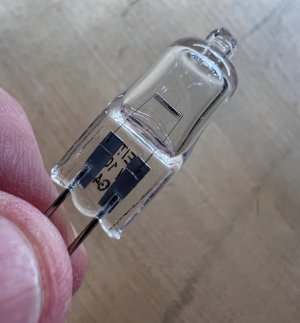InTheWoods
New Member
- Location
- Maryland

Here is a photo of a scientific effect that I took. It's two separate images of a light bulb filament. I exposed both images in exactly the same way. I used regulated DC power to light the bulb, and the polarity is different between the upper and lower images. Yes, the polarity of direct current does make a small difference in an incandescent light bulb! The reason is the Thomson Effect, which is part of the interrelated thermoelectric effects. The electrons in a metal, when flowing through the metal in an electric current, are able to sweep heat along with them as they flow. In the upper image the electrons flow left to right, and in the lower image they flow right to left. Most of the filament looks the same in both, but there's a subtle difference at the ends where the temperature is falling off. In the upper image the glow extends further on the right wire, whereas in the lower image the glow extends further in the left wire.
The bulb is tiny. I'm using a lot of magnification to see the filament details. Here's a picture of the bulb between my thumb and finger to give you an idea of its size.

I like macrophotography and also like photos capturing scientific effects and hard-to-see things.

